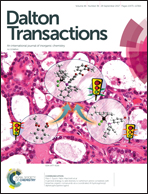NI(ii) phosphine and phosphide complexes supported by a PNP-pyrrole pincer ligand†
Abstract
The reaction between [(PNpyrP)NiCl] (1, PNpyrP = 2,5-bis((di-iso-propylphosphino)-methyl)-1H-pyrrolide) and TlPF6 in the presence of a monodentate phosphine ligand led to cationic nickel phosphine and phosphite complexes, [(PNpyrP)Ni(PHPh2)][PF6] (2), [(PNpyrP)Ni(PMe3)][PF6] (3), and [(PNpyrP)Ni{P(OMe)3}][PF6] (4). Compound 2 can be deprotonated resulting in the generation of a terminal phosphido complex, [(PNpyrP)Ni(PPh2)] (5). When 3 is subjected to a base, a methyl proton of PMe3 is abstracted to afford [(PNpyrP)Ni(CH2PMe2)] (6), containing a methylene bridge between Ni and the external phosphine. Compounds 2–6 were characterized by single crystal X-ray diffraction in addition to multi-nuclear NMR spectroscopy and elemental analysis.



 Please wait while we load your content...
Please wait while we load your content...